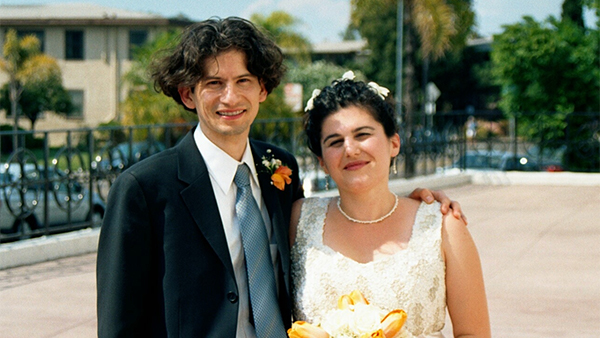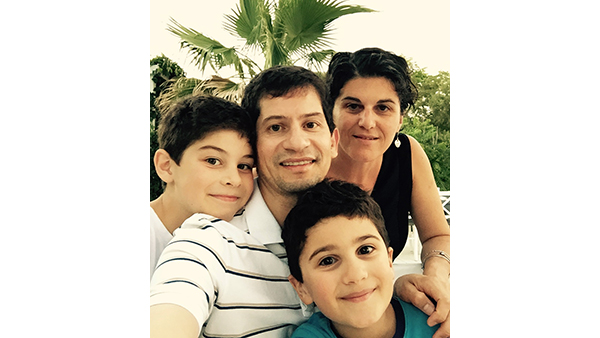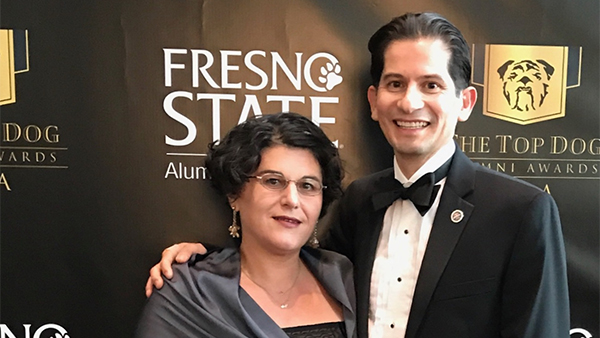|
On sunny and warm Fresno days — pre-pandemic — Interim President Saúl Jiménez-Sandoval and his wife, Dr. Mariana Anagnostopoulos, a professor in the Department of Philosophy, would meet up for lunch or to chat for a few minutes by the campus fountain or on a bench in the Peace Garden.
The couple met in graduate school and started a friendship that later blossomed into a romance through their studies, over a love of Oaxacan food at a Los Angeles restaurant, and with the unique culture and perspectives each brought to the relationship.
Life is a little different now as a result of the pandemic and the changes in campus roles for Interim President Jiménez-Sandoval. As Valentine's Day approaches, Campus News took some time to learn about their love story. Read on for more.
How did you two first meet?
We met in graduate school, when we were both chosen to serve as teaching associates for UC Irvine’s very challenging Humanities Core Course. The class brought together three humanities professors and covered literature, history, and philosophy, tapping advanced graduate students in each area. Mariana was included from philosophy and Saúl from Spanish and Portuguese. After Mariana presented her lesson plan on Plato’s Euthyphro for the group of professors and teaching associates, Saúl sent her an email congratulating her for her presentation and asking further questions on the material. From this initial email conversation, we exchanged numbers, started talking, and developed a friendship.
What are some early experiences that brought you closer together?
We successfully completed our respective dissertations over a summer, while residing again in the same city after a year apart. Having faced that challenge together, we felt closer and knew we could accomplish much more. Saúl began to read the Harry Potter books during this time, to take a break, but each time Mariana would call and ask, “what are you up to?” he would respond: “oh … ahem … I’m working on my chapter…” Despite all the work, it’s a time we remember fondly; after writing all day, we would get together for dinner or an outing.
During Mariana’s postdoc year in Los Angeles, Saúl would visit from Fresno, and we would frequent a nearby Oaxacan restaurant called La Guelaguetza (a mouthful to say, even in Spanish!). Since we enjoyed the food so much, we decided to have our honeymoon in Oaxaca. Our first trip to Mexico was special for its delicious food, great weather, and trips we took to the surrounding areas, including Monte Albán, Teotitlán del Valle, and San Bartolo Coyotepec.

|
|
(Interim President Saúl Jiménez-Sandoval and Dr. Mariana Anagnostopoulos at their wedding in 2002.)
|
How long have you been married?
We have been married for 18 years. We got married in San Diego, in a smallish big fat Greek wedding, with a French dinner at a Japanese garden. : )
What quality or qualities do you love most about each other?
Jiménez-Sandoval: Mariana grounds my energy, and helps me sharpen my focus on what is meaningful. She’s a great artist (drawing), has phenomenal editing skills, and has the most profound love for our family.
Anagnostopoulos: Saúl is deeply positive, discerning insight and creativity where they might be overlooked. Rejecting restrictive categories, he sees strength and vast potential in people, endeavors, and circumstances of all kinds. His drive to make a positive difference reminds me that progress can come in the form of small steps — each prompting growth and reflecting value.

|
|
(Interim President Saúl Jiménez-Sandoval and Dr. Mariana Anagnostopoulos in 2015 with their children Arion, then 9, and Leo, 7.)
|
What is a way each of you keeps the other close, when you are not together? How do the kids describe your connection?
Anagnostopoulos: Saúl finds me an interesting or unusual gift when travelling; last year, he gave me a heart-shaped ring that I keep on always.
Jiménez-Sandoval: Mariana wrote me letters from Greece long ago that I still keep; my favorite one, with a tree she drew in blue ink, is in my office.
Leo: “You’re like oil and lemon, that come together to create perfect harmony.”
Ari: “You’re like a force of nature, full of creativity and knowledge, yet still anchored in a center of love and family.”
What's your favorite trip you've ever taken together?
Jiménez-Sandoval: We have had many great trips. Mariana has the gift of finding super airfare deals (with reasonable routes), and unique hotels. I usually propose ideas on the destinations, and design an (overly ambitious) itinerary. My favorite trip was to the Cook Islands. We arrived and found out our phones had no coverage. At first I panicked, but by the second day, I felt liberated and was able to enjoy the best snorkeling we had experienced. Rarotonga, the main island, was relatively small — it took us 45 minutes driving at 40 miles an hour to circle the perimeter. The people were warm and welcoming, and the rukau greens were amazing!
Anagnostopoulos: The Rarotonga trip was our least-planned and most remote trip, chosen very quickly during a three-day airfare sale. It was calm and unique, in part because of the island's many free-roaming chickens — it was peaceful to sit on the porch watching them roam the (unfenced) yard. It is difficult for me to choose a favorite, as many experiences and places within different trips are memorable: an almost-empty restaurant above a large grass field above a small beach in a tiny Greek town, open-air markets and expansive central squares in Mexico, visiting deeply spiritual sites in Armenia, and many dessert stops at cafes or counters, especially for ice cream.
What have you enjoyed doing the most together pre-COVID and during the pandemic (if that has changed)?
This trying time has meant a loss of loved ones or livelihood for many people. We are aware of all that we have, as we modify our routines. Saúl works from the office, and Mariana and the boys from home (where she gets to experience middle and high school in a way she never anticipated).
Of course it has been difficult to restrict social time with family and friends. We have not been able to gather with Saúl’s brothers and sisters, who all live in the area. Maintaining safety protocols, we have visited only with Saúl’s dad and Mariana’s parents. Leo has learned old Spanish-language songs to sing to Papó, and a Greek song for his yiayia and pappou.
We have always enjoyed cooking together, but being home all day on weekends gave us the opportunity to cook more complex foods — and to bake too. The boys have more household responsibilities, and we are more aware of the interconnectedness of people, services, and businesses in our community.
What is it like to work on the same campus together?
We feel very fortunate to work on the same campus, and specifically at Fresno State. Our colleagues and students are inspiring and supportive, allowing us both to develop varied interests and to grow as members of a thriving community. It is nice for each of us to know the other is nearby, but we usually meet for lunch or a chat only every so often, especially as Saúl’s positions have become more demanding. Sometimes we take a few moments to sit by the fountain, or on a bench near the Peace Garden. Our kids have grown up attending Fresno State events with us (from opera to football games), and share our deep commitment to our University.
Have you had a big academic debate or argument and how did it end?
We tend to agree on many, if not all, issues pertaining to our fields of study and associated matters. Mariana has taught Saúl about Greek philosophy, and Saúl often relates ideas in critical theory and art history to Mariana. Saúl tends to think in terms of periods of thought and their main characteristics, while Mariana’s focus is more narrow, on the analysis of details and relations between ideas. When we have different perspectives, it is usually about emphasizing varied aspects of a whole picture. Though elements of our different fields of study (such as continental and analytic philosophical approaches) have been considered to clash, we find that they ultimately come together in interpretations of a complex world.
You both have strong connections to your family heritage. What have you each learned from the other that you now cherish?
We both appreciate the value of family history and traditions, especially those that reveal that food is meaningful beyond its nutritional value — it codifies relationships, events, memories, and so much more … For Arion’s 12th birthday, we cooked for him a meal that was all yellow (his favorite color): yellow heirloom tomato salad, yellow Greek avgolemono soup, and Spanish paella. We have each largely adapted to the other’s cuisine. When Saúl toasts dry chiles to prepare a Mexican dish, Mariana jokes that, “it smells just like my Greek village,” and she has a favored technique for wrapping tamales. Saúl is happy to make his own special version of Greek hortopita, a filo-wrapped cheese and zillion-veggie pan pie.
Valentine’s Day is coming. Is it something you celebrate or acknowledge in some way? What do you do and how do you involve your children?
We will come up with something low-key — perhaps this year Ari can tell us the story of Aphrodite’s birth and Leo can sing us some mariachi songs.
What does Valentine’s Day symbolize for you?
We asked the boys for their ideas:
Ari: “It is a time for enjoying the company of those you care about.”
Leo: “Valentine’s Day symbolizes appreciation for all people and the earth.”
|




